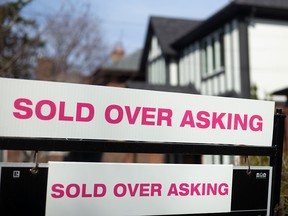Article content
I spend a lot of time thinking about Toronto real estate, talking about Toronto real estate, and reading all of the things and scrolling all of the tweets to see what others are saying about Toronto real estate.

I spend a lot of time thinking about Toronto real estate, talking about Toronto real estate, and reading all of the things and scrolling all of the tweets to see what others are saying about Toronto real estate.
And that’s when I am not actively selling it.
Opinions are everywhere and consensus is surely limited, but there are a few things that almost everyone seems to agree with: in the span of three decades, Toronto real estate has gone from mostly accessible to increasingly aspirational to broadly inaccessible.
We know that we have insufficient supply of both resale and rental housing.
We know that we have seemingly endless demand — thanks to bold immigration targets, job-seekers coalescing around the country’s business, financial and tech centre, not to mention historically low interest rates that have inarguably driven speculation, the ratio of available properties to active buyers is woefully inadequate.
And while it feels like there may be an ever so slight cool settling into the market in the past few weeks, if two years of forward momentum is any indication, it’s hard to believe this will be anything larger than a blip. But there are some signs. Houses that just weeks ago would have sold in a frenzy of over ten offers are now welcoming just a handful on offer night.



From there it seems to go one of two ways — the house still hits a strong number, likely driven by two motivated buyers battling it out between themselves, or it fails to sell and so is relisted the next day.
I sold a house this past week where we had over 50 showings. Respectfully declined a bully offer on day one, asking instead that they wait until offer night. This was one of those houses in one of those neighbourhoods that was sure to do well as it was the perfect starter home and a way of getting in. The house was adorable. It was staged perfectly. We were priced slightly below market value in order to ensure that we were driving activity and not confusing people about what our expectations were. I answered every phone call, followed up with every agent for feedback, sent out the home inspection report more times than I can count.
The morning of our offer day I started to make my calls to get a sense of who might be coming forward. And I couldn’t believe it — agents who had shown the property two, three and four times were telling me some variation of the refrain that their clients loved the house but were worried it was going to go too high and didn’t want to compete. They were going to sit it out.
In the end we had three offers. And all of them were strong. The buyers who showed up came to play. Gone were the buyers who were simply taking their shot. With all of the discussion about the perils of blind bidding, this was fascinating to me. It wasn’t a frenzy, no one lost their heads, the house sold for exactly what I expected it would.
But I do think the stars aligned for us. I think if my sellers had unrealistic expectations or the house had some challenges, or there had been a blizzard that made the parking situation difficult, we could have had a very different result.
And based on conversations with my colleagues, my experience this week was not unique. A friend had a similar scenario play out on her listing in the west end. In the end she got a record-setting price, but it was a small handful of offers that got her there. Another didn’t hit her number and they relisted the next day.
What could this mean? Well, for those who have made a full-time gig out of predicting the great crash, they will likely say that this is the sign that a seismic shift is underway. I think it’s a little simpler than that. People are uncertain and unsettled by what’s happening in the world. We are all exhausted. We are coming off of two years of a global pandemic while a hideous and horrifying war in Europe is now unfolding in real time on cable news and social media.
Buyers have been spooked by a lot less. The bump to interest rates was nominal relatively-speaking. Could people be alarmed by an economy grappling with elements we barely understand? Inflation that is clearly not transitory, an energy crisis, and gas prices that seem like typos? Absolutely.
Investors who actually know what they are doing are likely taking a good hard look at what’s driving current inflation and I’ll bet that many are now taking a pause. And I would also bet that there is a solid group of buyers who are now wondering if this is the moment some sanity starts to return to our real estate market. And for their sake I hope that’s exactly what’s happening.
But if recent history is any indication, this is just as likely to be one of those little blips that could actually represent a rare sliver of opportunity before the train powers up once again.
[unable to retrieve full-text content]
Banks Believe They Are Well-Prepared for Commercial Real Estate Fallout The Wall Street Journal





Source link
Robert McLister: Tax shelters don’t make housing more affordable, but those with the cash would be foolish not to use them


With housing unaffordability near its worst-ever level, our trusty leaders are on a quest to right their housing wrongs and get more young people into homes.
Part of Ottawa’s big strategy to “help” is promoting tax-sheltered savings accounts and pumping up their contribution limits. That, of course, stimulates real estate demand amidst Canada’s population and housing supply crises. But save that thought.
Advertisement 2
Article content
Article content
First-time buyers now have three government piggy banks to stockpile cash for a down payment:
1. The 32-year-old RRSP Home Buyers’ Plan — which lets you deduct contributions from your income to defer taxes and then borrow from the account interest-free for your down payment (as long as you wait 90-plus days to withdraw any contributions);
2. The 15-year-old Tax-free Savings Account (TFSA) — which lets you save after-tax dollars, grow your money tax-free and withdraw it without the taxman taking a bite;
3. The one-year-old First Home Savings Account (FHSA) — which is a combination of an RRSP and TFSA. It lets you deduct contributions from income, compound it tax-free and never pay tax on withdrawals used to buy a home. You can even save the deduction for a year when you need it more — when you’re earning more money.
Assuming you have the funds and contribution room, these tax shelters can combine to help you amass a supersized down payment.
“Looking at the FHSA alone, with the max annual contribution room of $8,000 for 2023 and 2024, a potential first-time home buyer could have as much as $16,000 deposited in the account today for a down payment,” says Eric Larocque, chief mortgage operations officer at Questrade’s Community Trust Company.
Article content
Advertisement 3
Article content
“If you also add in the cumulative contribution room of $95,000 for the TFSA, it amounts to $111,000 in potential funds available — and that’s before incorporating investment gains from either account.”
And it doesn’t stop there. RRSP, TFSA and FHSA savings limits keep increasing. If first-timers have enough contribution room, down payment savers in 2024 can sock away even more in these tax-sheltered troves.
“Factoring in the recent changes to the Home Buyers’ Plan, which now permits RRSP withdrawals of up to $60,000 — up from $35,000 — we land at a potential total of $171,000 in deposited funds that can be tapped for a first-time home buyer’s down payment,” Larocque adds.
That’s quite a wad — easily enough to cover the 20 per cent ($139,706) down payment required to avoid mandatory (and pricey) default insurance on the average home. Canada’s average abode is now worth $698,530 by the way, according to the Canadian Real Estate Association.
Here’s the rub: Canada’s living costs are sky-high, and real disposable income has trended downward. So, how’s an average first-time buyer household, raking in less than six figures, supposed to amass such a stash?
Advertisement 4
Article content
Based on national averages, saving 10 per cent of one’s pre-tax income per year (who does that?) would take a young FTB couple over 15 years to sock away $140,000. History shows what would happen to home values if you waited 15 years — they’d jet off without you.
If you have no other resources and your bet is that historical appreciation rates continue — despite slower population growth, more building and potentially higher long-term rates — you’re better off saving less and buying sooner with a five per cent down insured mortgage.
So, does Big Brother really expect your typical first-time buyer to max out all these savings plans? Nope. But hey, throwing a buffet of options at you sure paints a pretty picture of government effort, doesn’t it?
Ottawa’s dirty little secret is that these nifty programs crank up demand, turning renters into buyers. So don’t bet on them making the home-owning dream any cheaper, for first-timers or anyone else.
Take advantage of them anyway.
The government sets limits on these tax shelters with well-off home buyers in mind. One lucky bunch who can make use of all three down payment savings plans is the first-timer with prosperous parents.
Advertisement 5
Article content
Such buyers can make a withdrawal from their parental ATM (a living inheritance, some call it), deposit that cash in all three savings vehicles above and reap: hefty income tax savings or deferrals (thanks to the FHSA and RRSP deductions); tax-free/tax-deferred growth on the investments; and tax-free withdrawals if the money is used to buy a qualifying home (albeit, you’ll have to pay the RRSP HBP back over 15 years, starting five years after your withdrawal).
Recommended from Editorial
The more opportunities it gives people to save for a down payment, the more Ottawa worsens the imbalance between purchase demand and supply. And that, of course, boosts real estate values skyward — which is dandy for existing owners but contradictory to the government’s affordability messaging.
But hey, these tax treats are ripe for the picking. Home shoppers with the means — especially those with deep-pocketed parents — might as well take advantage of all three accounts.
Robert McLister is a mortgage strategist, interest rate analyst and editor of MortgageLogic.news. You can follow him on X at @RobMcLister.
Article content

Successful real estate investors have long followed the adage: When there is blood in the street, buy property.
Historically, this approach has yielded dividends, and it explains the mindset behind a new venture from Hines, a real estate giant with over $93 billion in assets under management. Hines recently announced a new platform called Hines Private Wealth Solutions that seeks to capitalize on the recent troubles in the real estate industry.
The management at Hines has been carefully watching the real estate industry for decades, and they believe that today’s market presents the perfect opportunity for investors to buy distressed assets and sell them at a profit in the future. When you consider that nearly $4 trillion in commercial real estate loans are set to mature between now and 2027, it’s easy to see the logic behind Hines Private Wealth Solutions.
The developers behind many of those projects took out loans assuming they would be able to refinance at pre-COVID interest rates. Considering that current interest rates are about double what they were before COVID-19, that assumption looks more like a losing bet every day. It also means there will be a lot of foreclosures that a well-positioned fund can snap up for pennies on the dollar.
Don’t Miss:
That’s where Hines Private Wealth Solutions seeks to step into the picture. It’s already contracted with investing heavyweight Paul Ferraro, former head of Carlyle Private Wealth Group, and raised $10 billion in funds for the new project. It will offer its clients a range of investment options, including:
In addition to these offerings, Hines will also give personal guidance to its investors on how to best manage their real estate assets. It is targeting investors who want to turn away from the traditional 60/40 investment model by channeling more money into real estate and away from other alternative investments. Hines is banking on the idea that high interest rates and high inflation will be around for a while.
Trending
When that happens, it becomes more important for investors to hold inflation-resistant assets. That’s a big part of why Hines is betting that real estate is near the bottom after years of declining profits resulting from high interest rates and major losses in the commercial sector. Hines’s conclusion that now is the time to buy real estate is based on long-term company research showing that real estate typically declines after a 15- to 17-year-long growth period.
Its research shows that the decline normally lasts around two years, which is about the same length of time the real estate market has been suffering from high prices and high interest rates. Theoretically, that makes this the perfect time to make aggressive moves in the real estate market, and the Hines Private Wealth Fund was conceived to allow investors to take advantage of current market conditions.
Despite the deep troubles facing today’s real estate industry, it’s not hard to see the logic in Hines’s approach.
“This is a great vintage, it’s a great moment. This real estate correction began really over two years ago, right when the Fed started raising interest rates,” Hines global Chief Investment Officer David Steinbach told Fortune magazine. “So, we’re two years into a cycle, which means we’re near the end.”
If Hines is correct, real estate investors will have a lot of good bargains with high upside to choose from in the next 12 to 24 months. The good news is that even if you’re not wealthy enough to buy into the Hines Private Wealth Solution, there may still be plenty of opportunity for you to adopt their investment philosophy and start scouting for an undervalued, distressed asset to scoop up. Keep your eyes open and be ready.
Read Next:
“ACTIVE INVESTORS’ SECRET WEAPON” Supercharge Your Stock Market Game with the #1 “news & everything else” trading tool: Benzinga Pro – Click here to start Your 14-Day Trial Now!
Get the latest stock analysis from Benzinga?
This article $93 Billion Real Estate Giant Is Betting The Market Is About To Hit Rock Bottom originally appeared on Benzinga.com
© 2024 Benzinga.com. Benzinga does not provide investment advice. All rights reserved.




UK Mulls New Curbs on Outbound Investment Over Security Risks – BNN Bloomberg




Auston Matthews denied 70th goal as depleted Leafs lose last regular-season game – Toronto Sun
Trump Media alerts Nasdaq to potential market manipulation from 'naked' short selling of DJT stock – CNBC
BC short-term rental rules take effect May 1 – CityNews Vancouver
Collection of First Nations art stolen from Gordon Head home – Times Colonist




Benjamin Bergen: Why would anyone invest in Canada now? – National Post




Save $700 Off This 4K Projector at Amazon While You Still Can – CNET




'Kingdom Come: Deliverance II' Revealed In Epic New Trailer And It Looks Incredible – Forbes
Comments